LG Electronics USA LGSBW51 RF Module User Manual
LG Electronics USA RF Module Users Manual
Users Manual
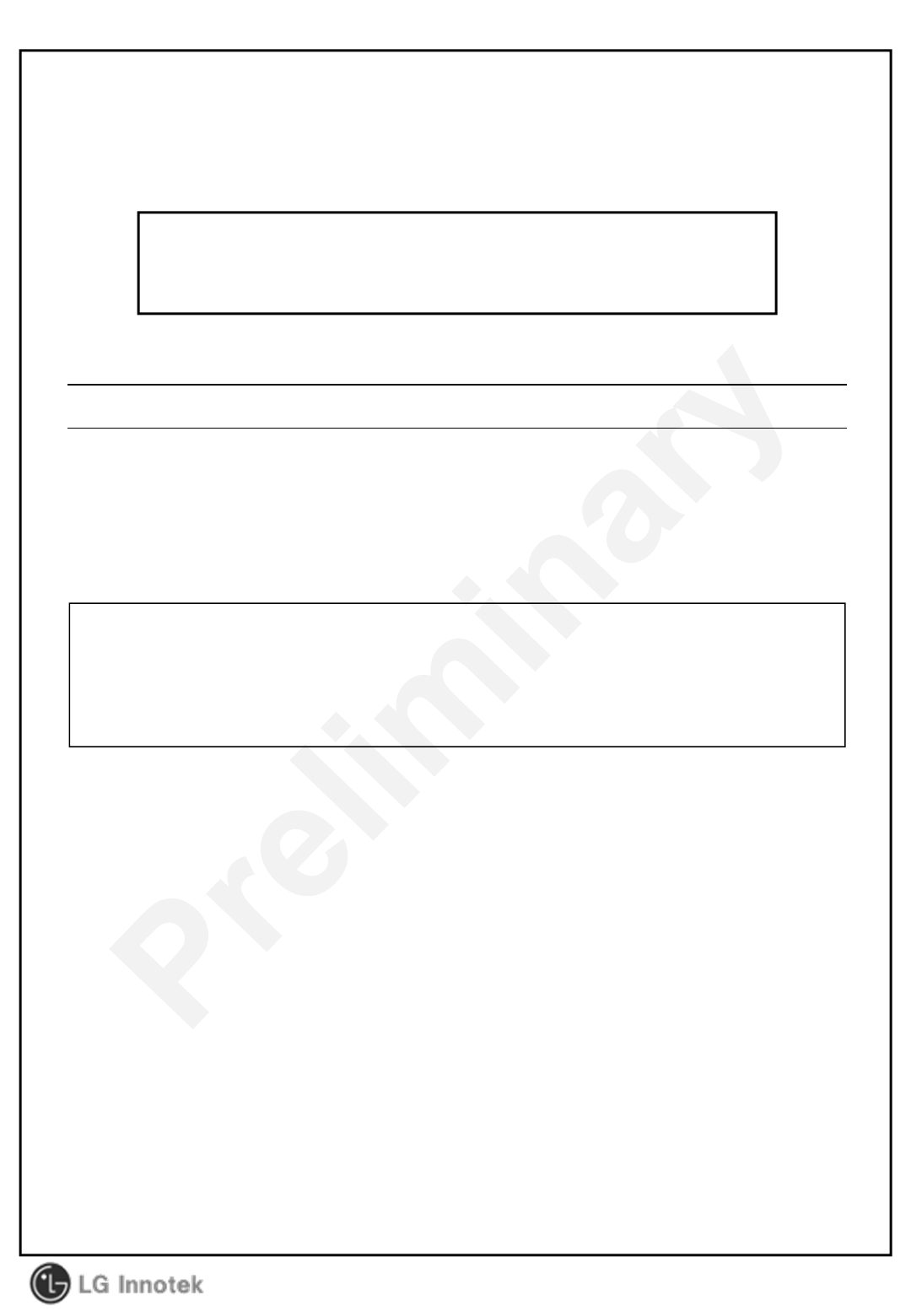
User Manual
PRODUCT NAME : RF Module
MODEL NAME : LGSBW51
(00)-0073
The information contained herein is the exclusive property of LG Innotek
and shall not be distributed, reproduced or disclosed in whole or no in part
without prior written permission of LG Innotek.
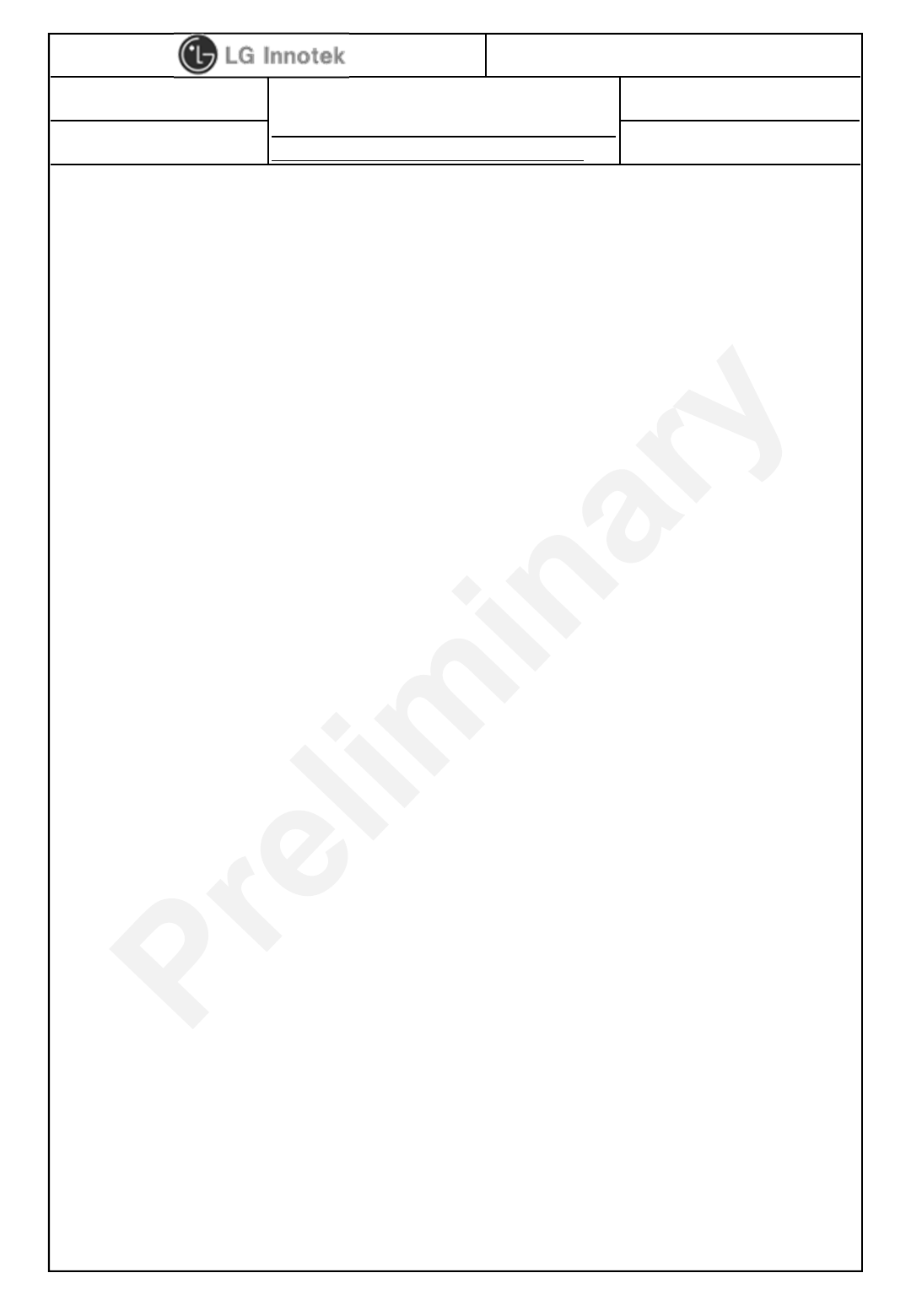
User Manual
PAGE :
DOCUMENT No :
REG. DATE : 2014.09.24
MODEL NAME: TWCM-B201D(LGIT)
LGSBW51(LGE)
REV. DATE : 2014.09.24
REV.NO : v0.01
-
Copyrightⓒ. 2014. All Rights Reserved.
1/ 9
Index
No Description Page
1 Features 2
2 Picture of Product 2
3 Installation Manual 3
4 Block Diagram 4
5 Absolute Maximum Ratings 4
6 Operating Conditions 5
7 Standard Test Conditions 5
8 Pin Description 6
9 Out Drawing 7
10 Packing Information 8
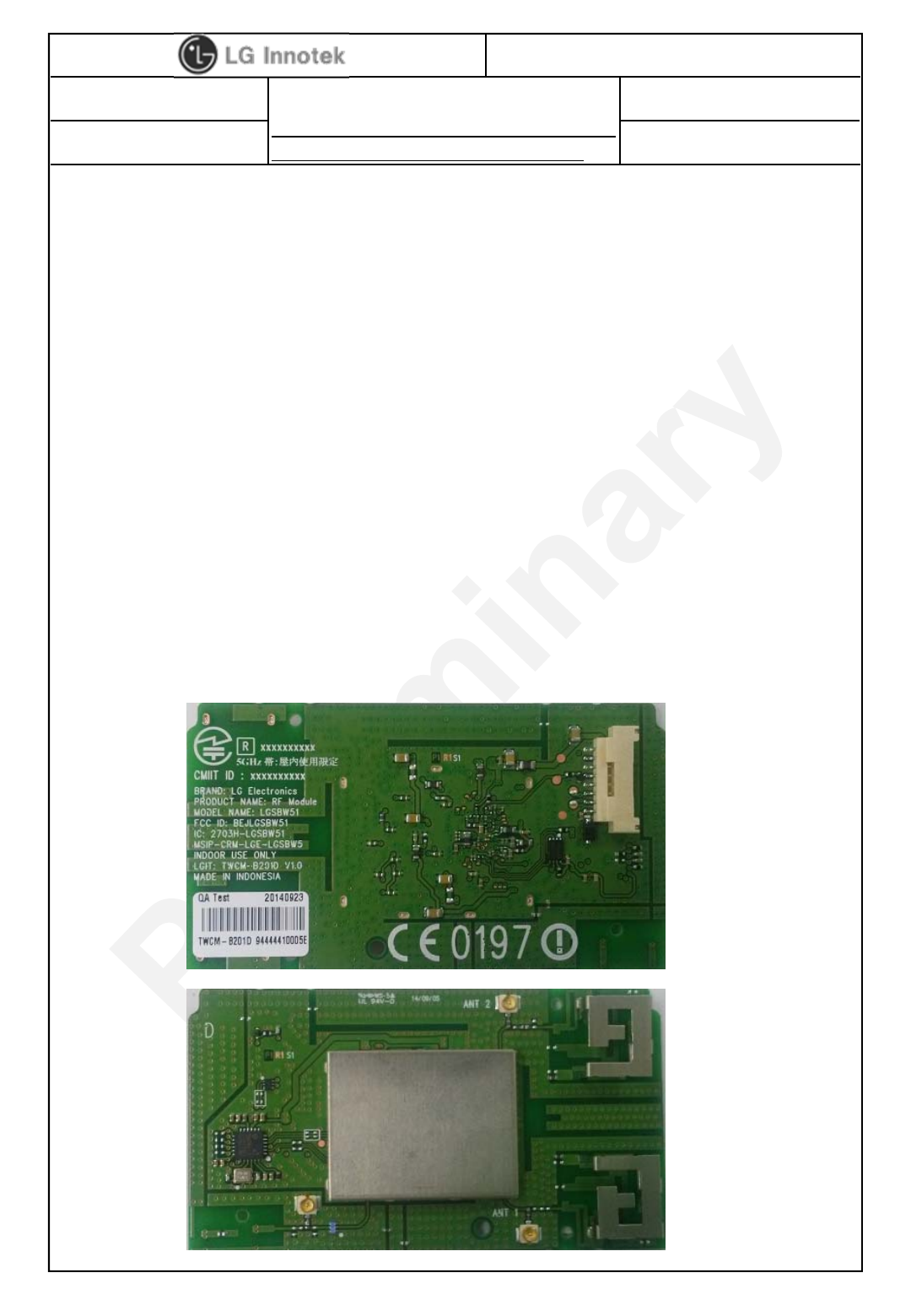
User Manual
PAGE :
DOCUMENT No :
REG. DATE : 2014.09.24
MODEL NAME: TWCM-B201D(LGIT)
LGSBW51(LGE)
REV. DATE : 2014.09.24
REV.NO : v0.01
-
Copyrightⓒ. 2014. All Rights Reserved.
2/ 9
2. Picture of Product
1. Features
TWCM-B201D is the small size and low power module for IEEE 802.11ac wireless LAN
& BT4.0 + HS. TWCM-B201D is based on Broadcom BCM43569 solution.
IEEE 802.11 a/b/g/n/ac Dual Band WLAN infrastructure
Bluetooth 4.0 + HS
Size : 68.0mm x 38.0mm
Two stream spatial multiplexing up to 300Mbps(802.11n)/ 867Mbps(802.11ac)
WLAN Metal Press antenna, BT Printed antenna on
Use on-chip OTP (One-Time Programmable)
Host Interface : USB2.0 (WLAN & BT)
- This model is using the common USB2.0 to control WLAN and BT
Security : WAPI, WEP, WPA, WPA2, WMM, AES, WEP, TKIP, CKP
Application: DTV, DVR, HD DVD Player, Blue-ray Disk Player, STB
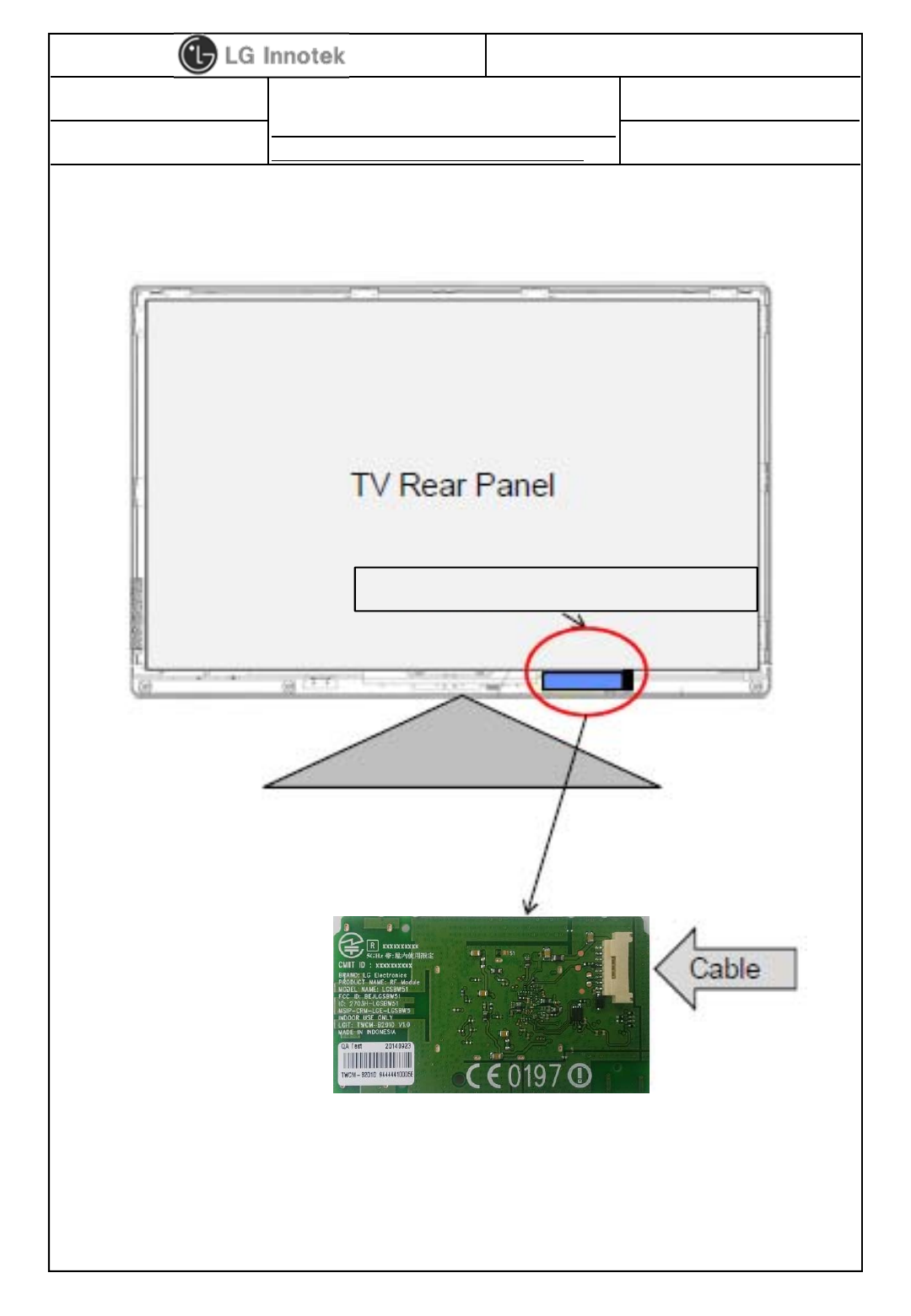
User Manual
PAGE :
DOCUMENT No :
REG. DATE : 2014.09.24
MODEL NAME: TWCM-B201D(LGIT)
LGSBW51(LGE)
REV. DATE : 2014.09.24
REV.NO : v0.01
-
Copyrightⓒ. 2014. All Rights Reserved.
3/ 9
3. Installation Manual
TWCM-B201D installed position
Install the module like below in the back of the TV
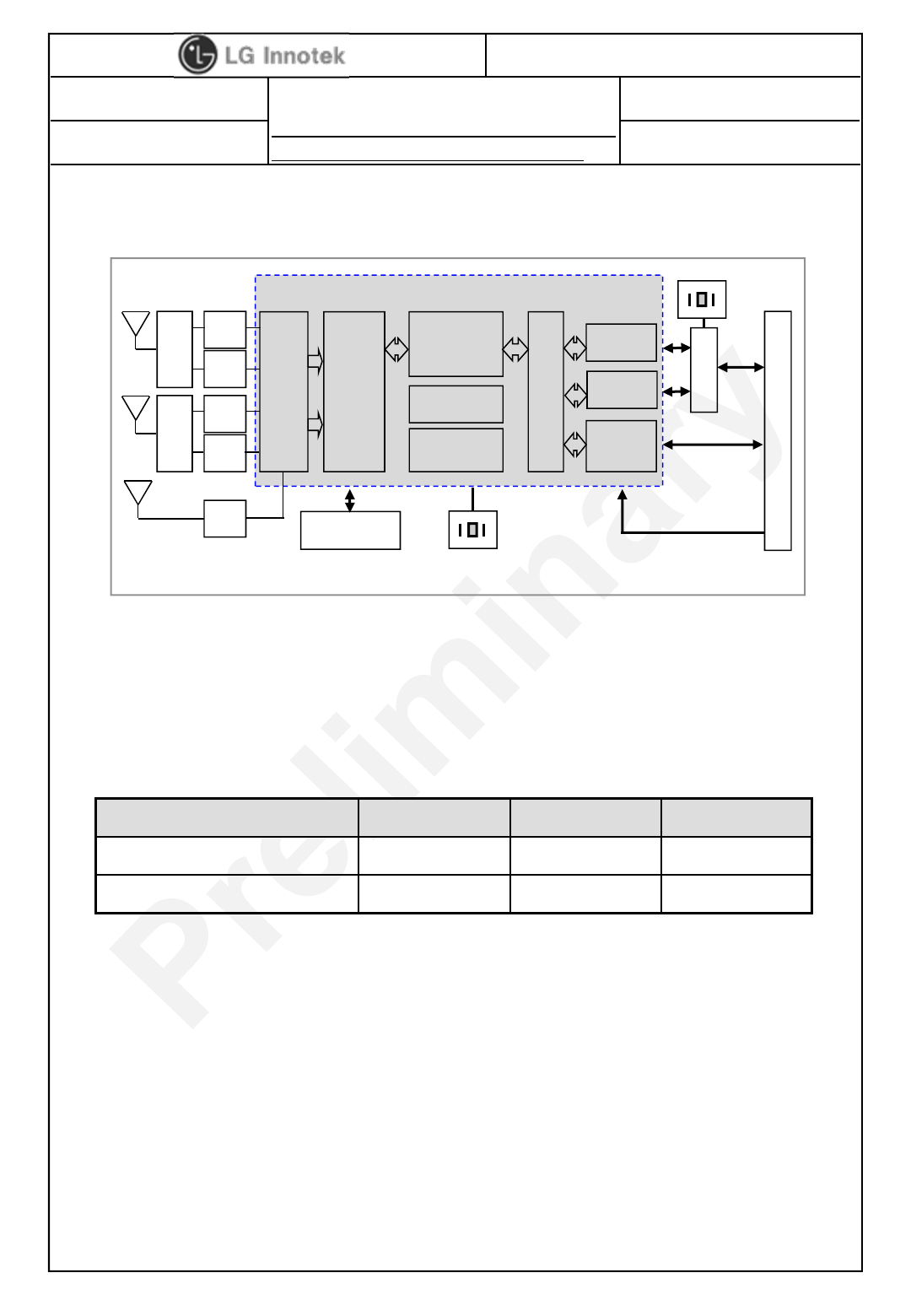
User Manual
PAGE :
DOCUMENT No :
REG. DATE : 2014.09.24
MODEL NAME: TWCM-B201D(LGIT)
LGSBW51(LGE)
REV. DATE : 2014.09.24
REV.NO : v0.01
-
Copyrightⓒ. 2014. All Rights Reserved.
4/ 9
4. Block Diagram
3.3V
802.11ac MAC
Main Clock(40MHz)
ANT1
2 x 2
Radio 802.11ac
PHY Security
OTP
Internal Bus
GPIO
WLAN
USB 2.0
BCM43569
Connector
5G
SPDT
2G
SPDT
5G
SPDT
2G
SPDT
Diplexer
ANT0
Diplexer
LPF
BT ANT Serial Flash (1M)
BT
USB 2.0
USB HUB
USB Hub Clock_(24MHz)
5. Absolute Maximum Ratings
Parameter Min Max Unit
Storage Temperature -20 +80 ℃
Storage Humidity (40℃)-90%
Caution : The specifications in Table 1 define levels at which permanent damage to the
device can occur. Function operation is not guaranteed under these conditions.
Operating at absolute maximum conditions for extend periods can adversely affect the
long-term reliability of the device.
. Other conditions
1) Do not use or store modules in the corrosive atmosphere, especially where chloride
gas, sulfide gas, acid, alkali, salt or the like are contained.
Also, avoid exposure to moisture.
2) Store the modules where the temperature
and relative humidity do not exceed 5 to 40℃and 20 to 60%.
3) Assemble the modules within 6 months.
Check the soldering ability in case of 6 months over.
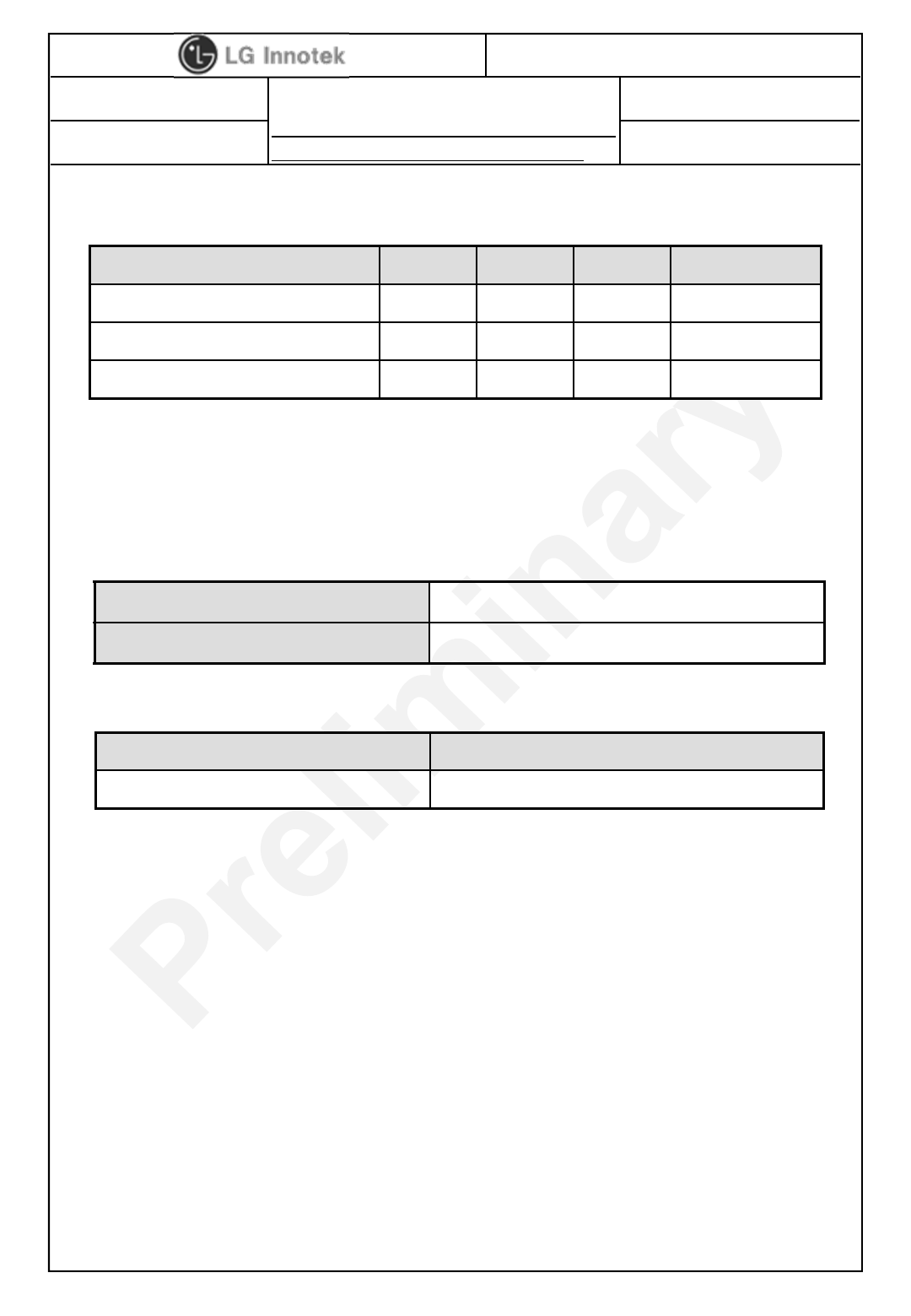
User Manual
PAGE :
DOCUMENT No :
REG. DATE : 2014.09.24
MODEL NAME: TWCM-B201D(LGIT)
LGSBW51(LGE)
REV. DATE : 2014.09.24
REV.NO : v0.01
-
Copyrightⓒ. 2014. All Rights Reserved.
5/ 9
6. Operating Conditions
Parameter Min Typ Max Unit
Ambient Temperature 0 - 60 ℃
Ambient Humidity (40℃)--85 %
Supply Voltage 4.75 5.0 5.25 Vdc
7. Standard Test Conditions
The Test for electrical specification shall be performed under the following condition
Otherwise this following conditions, not guaranteed this performance.
Temparature 25 ±5℃
Humidity 65 ±5%
Input Voltage Supply Voltage
VDD_3.3V +3.3V ±0.165V
7-1. Ambient condition
7-2. Power supply voltages
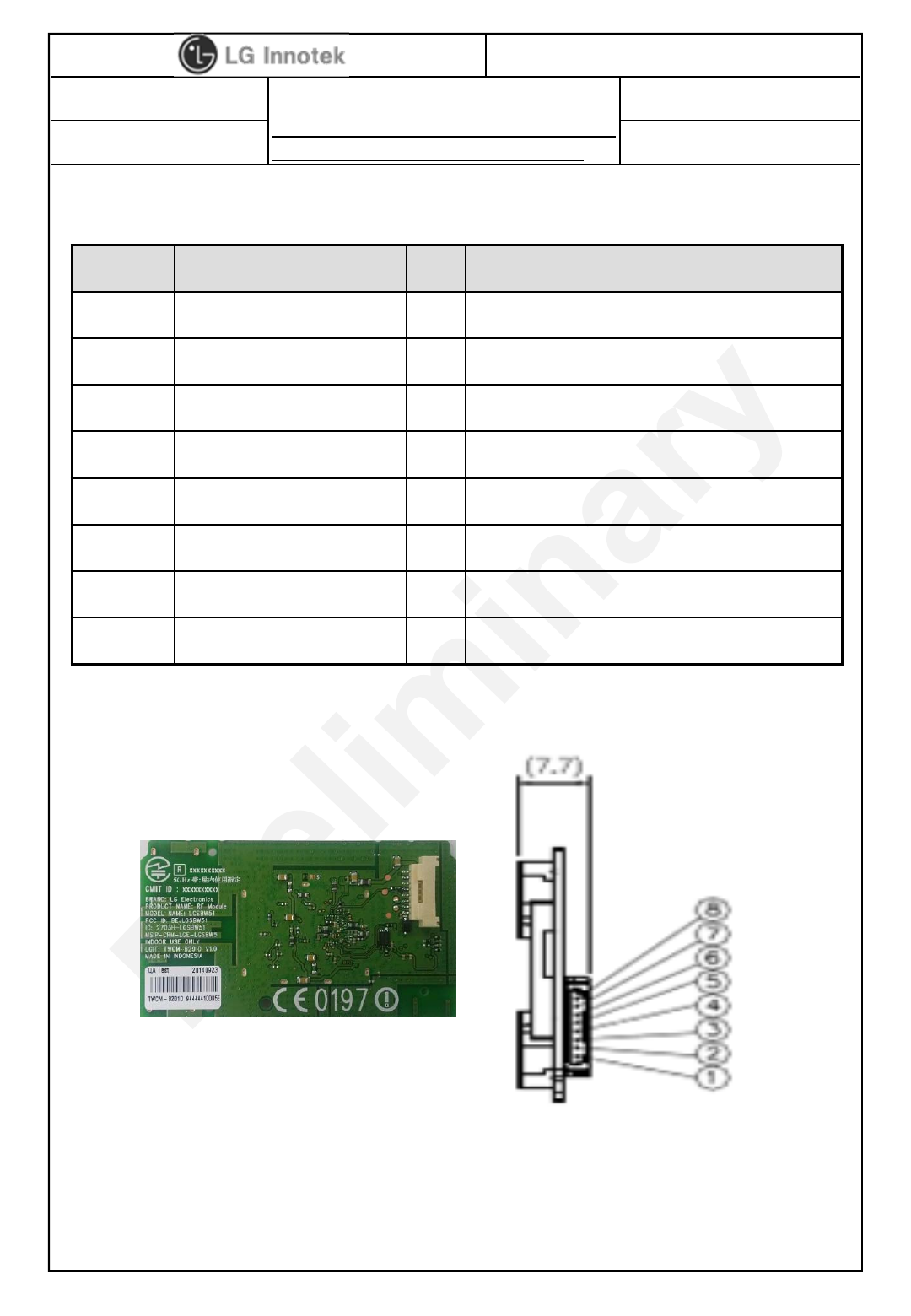
User Manual
PAGE :
DOCUMENT No :
REG. DATE : 2014.09.24
MODEL NAME: TWCM-B201D(LGIT)
LGSBW51(LGE)
REV. DATE : 2014.09.24
REV.NO : v0.01
-
Copyrightⓒ. 2014. All Rights Reserved.
6/ 9
8. Pin Description
Pin No. Pin Name I/O Pin Description
1 VCC I +3.3V
2 WLAN USB D- I/O USB Communication signal USB_DN
3 WLAN USB D+ I/O USB Communication signal USB_DP
4 GND - Ground
5 WLAN_WAKE_HOST O WLAN wake-up signal
6 GND - Ground
7 BT_WAKE_HOST O Bluetooth wake-up signal
8 GND - Ground
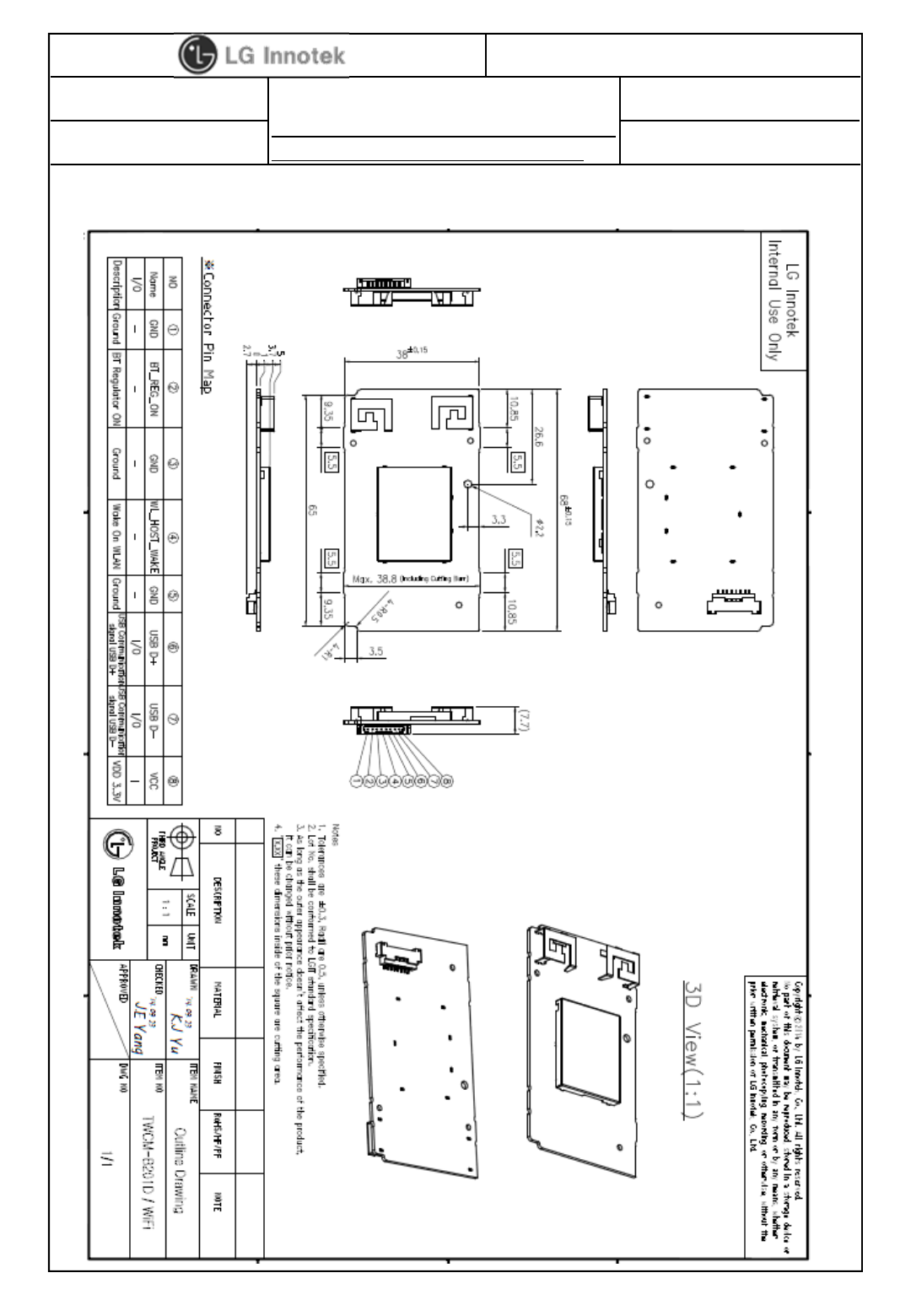
User Manual
PAGE :
DOCUMENT No :
REG. DATE : 2014.09.24
MODEL NAME: TWCM-B201D(LGIT)
LGSBW51(LGE)
REV. DATE : 2014.09.24
REV.NO : v0.01
-
Copyrightⓒ. 2014. All Rights Reserved.
7/ 9
9. Outline Drawing
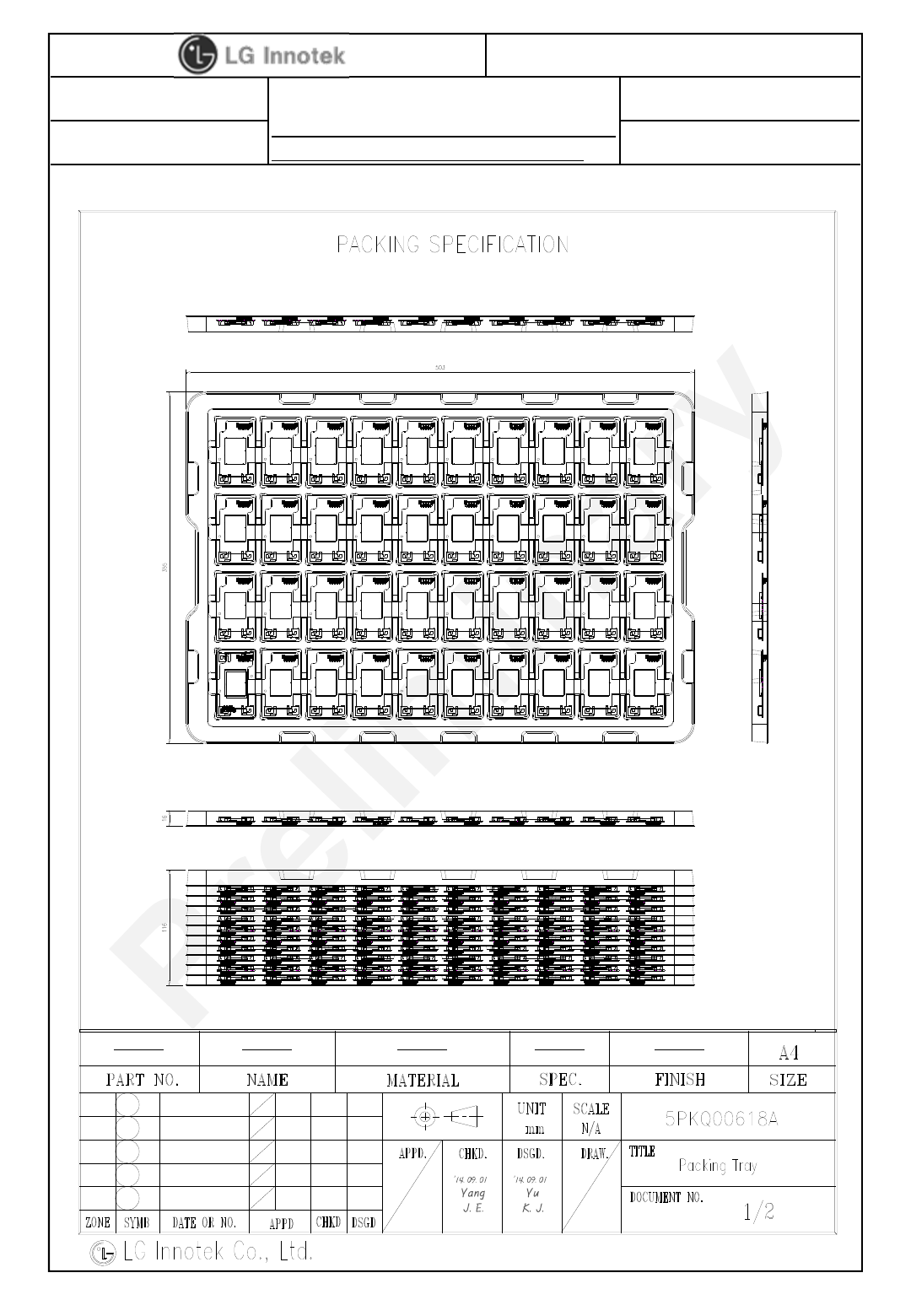
User Manual
PAGE :
DOCUMENT No :
REG. DATE : 2014.09.24
MODEL NAME: TWCM-B201D(LGIT)
LGSBW51(LGE)
REV. DATE : 2014.09.24
REV.NO : v0.01
-
Copyrightⓒ. 2014. All Rights Reserved.
8/ 9
10. Packing Information
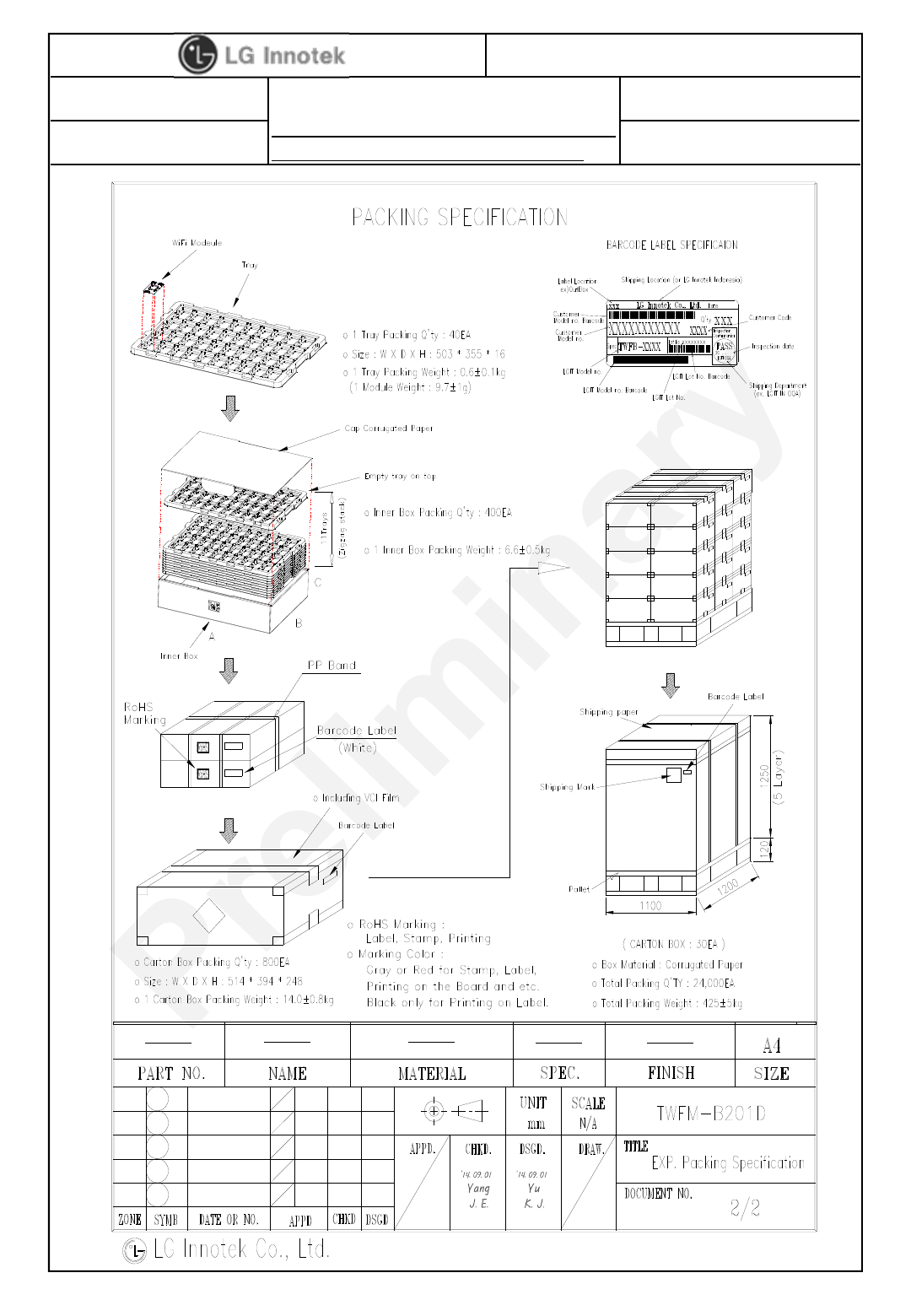
User Manual
PAGE :
DOCUMENT No :
REG. DATE : 2014.09.24
MODEL NAME: TWCM-B201D(LGIT)
LGSBW51(LGE)
REV. DATE : 2014.09.24
REV.NO : v0.01
-
Copyrightⓒ. 2014. All Rights Reserved.
9/ 9
1. FCC
FCC Statements:
This device complies with Part 15 of the FCC Rules. Operation is subject to the following two
conditions:
(1) this device may not cause harmful interference, and
(2) this device must accept any interference received, including interference that may
cause undesired operation.
End Product Labeling
The module is labeled with its own FCC ID and IC Certification Number. If the FCC ID and IC
Certification Number are not visible when the module is installed inside another device, then the
outside of the device into which the module is installed must also display a label referring to the
enclosed module. In that case, the final end product must be labeled in a visible area with the
following:
“Contains FCC ID: %(-/*6%:”
“Contains IC: +/*6%:”
The OEM integrator has to be aware not to provide information to the end user regarding how to
install or remove this RF module or change RF related parameters in the user manual of the end
product.
OEM Responsibilities to comply with FCC and Industry Canada Regulations
The module has been certified for integration into products only by OEM integrators under the
following condition:
- The antenna(s) must be installed such that a minimum separation distance of at least 20 cm is
maintained between the radiator (antenna) and all persons at all times.
- The transmitter module must not be co-located or operating in conjunction with any other
antenna or transmitter except in accordance with FCC multi-transmitter product procedures.
As long as the two condition above is met, further transmitter testing will not be required.
However, the OEM integrator is still responsible for testing their end-product for any additional
compliance requirements required with this module installed (for example, digital device
emissions, PC peripheral requirements, etc.).
Regulatory Notices
IMPORTANT NOTE: In the event that these conditions can’t be met (for certain configurations or
co-location with another transmitter), then the FCC and Industry Canada authorizations are no longer
considered valid and the FCC ID and IC Certification Number can’t be used on the final product. In
these circumstances, the OEM integrator will be responsible for re-evaluating the end product
(including the transmitter) and obtaining a separate FCC and Industry Canada authorization.
FCC Part 15.105 statement
This equipment has been tested and found to comply with the limits for a Class B digital device,
pursuant to part 15 of the FCC Rules.
These limits are designed to provide reasonable protection against harmful interference in a residential
installation. This equipment generates, uses and can radiate radio frequency energy and, if not
installed and used in accordance with the instructions, may cause harmful interference to radio
communications. However, there is no guarantee that interference will not occur in a particular
installation. If this equipment does cause harmful interference to radio or television reception, which
can be determined by turning the equipment off and on, the user is encouraged to try to correct the
interference by one or more of the following measures:
- Reorient or relocate the receiving antenna.
- Increase the separation between the equipment and receiver.
- Connect the equipment into an outlet on a circuit different from that to which the receiver is
connected.
- Consult the dealer or an experienced radio/TV technician for help.
2. IC
Étiquetage du produit final (IC)
Le module BT111 est étiqueté avec sa propre identification FCC et son propre numéro de
certification IC. Si l’identification FCC et le numéro de certification IC ne sont pas visibles lorsque
le module est installé à l’intérieur d’un autre dispositif, la partie externe du dispositif dans lequel
le module est installé devra également présenter une étiquette faisant référence au module inclus.
Dans ce cas, le produit final devra être étiqueté sur une zone visible avec les informations
suivantes :
« Contient module émetteur identification FCC ID: %(-/*6%:
« Contient module émetteur IC : +/*6%:
Dans le guide d’utilisation du produit final, l’intégrateur OEM doit s’abstenir de fournir des
informations à l’utilisateur final portant sur les procédures à suivre pour installer ou retirer ce
module RF ou pour changer les paramètres RF.
Responsabilités des OEM quant à la conformité avec les réglementations de FCC et d’
Industrie Canada
Les modules ont été certifiés pour entrer dans la fabrication de produits exclusivement réalisés
par des intégrateurs dans les conditions suivantes :
- L’antenne (ou les antennes) doit être installée de façon à maintenir à tout instant une distance
minimum de au moins 20 cm entre la source de radiation (l’antenne) et toute personne physique.
- Le module transmetteur ne doit pas être installé ou utilisé en concomitance avec une autre
antenne ou un autre transmetteur.
Tant que ces deux conditions sont réunies, il n’est pas nécessaire de procéder à des tests
supplémentaires sur le transmetteur. Cependant, l’intégrateur est responsable des tests
effectués sur le produit final afin de se mettre en conformité avec d’éventuelles exigences
complémentaires lorsque le module est installé (exemple : émissions provenant d’appareils
numériques, exigences vis-à-vis de périphériques informatiques, etc.)
REMARQUE IMPORTANTE : En cas d’inobservance de ces conditions (en ce qui concerne
certaines configurations ou l’emplacement du dispositif à proximité d’un autre émetteur), les
autorisations de FCC et d’Industrie Canada ne seront plus considérées valables et l’identification
de FCC et le numéro de certification d’IC ne pourront pas être utilisés sur le produit final. Dans
ces cas, l’intégrateur OEM sera chargé d’évaluer à nouveau le produit final (y compris l’émetteur)
et d’obtenir une autorisation indépendante de FCC et d’Industrie Canada.
IC warning
This device complies with Industry Canada licence-exempt RSS standard(s).
Operation is subject to the following two conditions : (1) this device may not cause interference, and
(2) this device musrt accept any interference, including interference that may cause undesired
operation of the device.
Le présent appareil est conforme aux CNR d'Industrie Canada applicables aux appareils radio
exempts de licence.
L'exploitation est autorisée aux deux conditions suivantes :
(1) l'appareil ne doit pas produire de brouillage, et
(2) l'utilisateur de l'appareil doit accepter tout brouillage radioélectrique subi, même si le
brouillage est susceptible d'en compromettre le fonctionnement.
Caution: Any changes or modifications to this device not explicitly approved by manufacturer could void
your authority to operate thisequipment.Attention:
Les changements ou modifications de cet appareil non expressément approuvé par le fabricant peuvent
annuler votre droit à utiliser cet équipement.